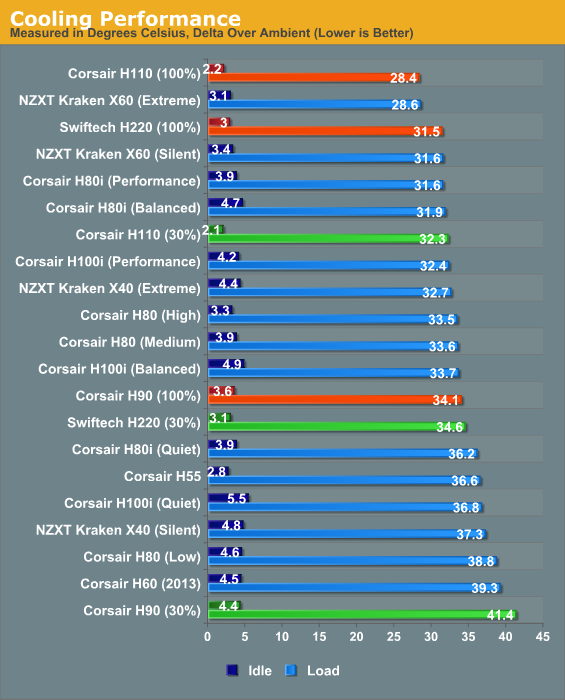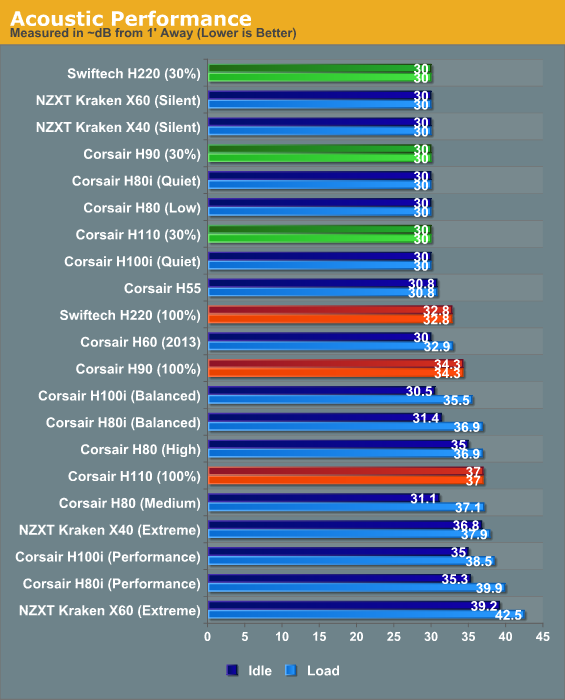Closing the Loop II: New Liquid Coolers from Corsair and Swiftech
by Dustin Sklavos on February 1, 2013 12:01 AM EST- Posted in
- Cases/Cooling/PSUs
- Corsair
- radiator
- Swiftech
Performance Results
I mentioned in the introduction that the new Corsair radiators are operating off of the same OEM hardware as NZXT's resident 140mm-based radiators. What I didn't mention was that Corsair doesn't have any software control for the fans or even any allowances made towards connecting and controlling the fans at all beyond the conventional motherboard headers. Corsair needs to hope the fans used on their H90 and H110 are enough to differentiate them from NZXT's Kraken series.
Swiftech, meanwhile, also uses PWM control, but includes a breakout block with the H220 to connect as many as seven different fans to a single PWM channel. It's worth noting, too, that though the Swiftech H220 is a 240mm radiator (like the Corsair H100i), the building materials and pump are almost completely different. The pump uses Swiftech's own secret sauce, while the radiator uses brass and copper instead of the garden variety aluminum the other radiators use. On top of this, they're using their own fans. Suffice to say, it's going to be interesting to see if the H220 can prove the extra effort and higher quality components are worthwhile.

Whether it's Corsair, NZXT, or good old-fashioned Asetek, the results don't lie: the 280mm radiator is just plain more efficient than any smaller block. Swiftech's H220 puts in a reasonably strong showing, though interestingly it has trouble overtaking the Corsair H80i at higher speeds. There's a very good reason for that, though, and you'll see it in a second.
Meanwhile, Asetek's single 140mm radiator basically continues to be a bust. It's by no means a terrible product, but the H90 and Kraken X40 are both pretty underwhelming. A thicker 120mm radiator with two fans continues to be a comparable if not superior choice.

If the Swiftech H220's performance is a little underwhelming, this is why. The H220 itself is definitely a strong radiator, but Swiftech clearly tuned their fans for acoustics instead of performance. At 30% fan speed only the X60 and H110 can offer both better thermal performance and fan speed, but at 100% fan speed, the louder, more aggressive fans are just able to push more cool air through their respective radiators.
What must be kept in mind is that while the H220 isn't necessarily blowing up the charts, the noise levels and thermal performance need to be connected and placed in context. The H220 is able to deliver competitive performance at lower noise levels than the competing radiators, and really only has to worry about the Corsair H110 and Kraken X60 beating it. Both of those are much harder to fit into most cases, too, a problem the Swiftech H220 doesn't have.










53 Comments
View All Comments
chaos215bar2 - Monday, February 4, 2013 - link
I'm not sure why you got the impression that the H220 couldn't compete. Overall, I got the impression that the H220 was one of the best coolers reviewed. It just sacrificed a little performance for a significant reduction in noise.ypsylon - Friday, February 1, 2013 - link
I would jump into H220 immediately. Drooling on it since first news appeared. Unfortunately there is small issue - nobody selling this thing in Europe. I inquired in few places across EU and so far nobody is eager to jump on it. Importing it from US is out of the question as I could build full custom loop for money spend on H220+S&H+VAT+2.5% duty fee. Still I have ~40 days ahead before planned WS switchover. If I can get H220 in that time I would, otherwise going with H100i + 4 AeroCool BlackSharks. Not interested in AIO 140/280.Nickel020 - Monday, February 11, 2013 - link
Actually, highflow.nl already has it on pre-order and usually offers quite reasonable shipping rates across Europe:http://highflow.nl/watercooling-sets/cpu-sets/swif...
More shops should be listing it once it actually becomes available.
BrightCandle - Friday, February 1, 2013 - link
Its not uncommon for a custom loop to get down to +25C at load, so these bigger radiator designs are starting to get really close to the performance of going fully custom at a lot less cost and hassle.ShieTar - Friday, February 1, 2013 - link
Sure. Now if those would just be provided for the 225W GPU instead of the 77W CPU, they might get actually relevant for a gaming computer.pcfxer - Friday, February 1, 2013 - link
BINGO!This man ^^^^^ has got it. Why the hell aren't they hooking these up to GPUs? Does a closed loop kit for GPUs even exists? I've had one video card die from a heavy HSF combo and I still hate seeing that much flex in card.
A closed loop setup is literally perfect for this. Any pump noise and fan noise from that would be worth it (if still reasonable, I normally hunt for options on SPCR).
Death666Angel - Friday, February 1, 2013 - link
There is the "Arctic Cooling Accelero Hybrid" and you can buy mounting kits for these CLCs to install on your GPU of choice. No full body CLCs I am aware of other than that. And since there are so many different layouts and removing the heatsink of most graphics cards voids the warranty, the market seems very small compared to these CPU CLCs.Runamok81 - Sunday, February 3, 2013 - link
With the help of custom brackets from triptcc.com modders have been installing closed loop GPU coolers for years.Jeaux Bleaux - Saturday, February 2, 2013 - link
From the article you didn't read; "At CES, the H220's pump was demonstrated keeping a pair of GTX 680s and an i7 cool."MadAd - Friday, February 1, 2013 - link
1- Corsair dropped the ball with me with my H60 recently. The pump was shrieking until i installed a fanmate to limit it to about 2k rpm (my friends coolit works at about 4k normally). The through board fittings were so sloppy I had to find 4 small washers to brace the board against the clamp or suffer less pressure on the cpu mount and to cap it all the fan they supplied committed both sins of a bad silent fan, high turbine noise AND a ticky motor noise. Probably one of the worst fans ive ever owned (and ive spend hundreds on specialist panaflos, scythes etc through the years).2- I would like to see reviews of these done in a fully loaded system too. That puny board with no GPU does not represent a normal PC at all. Yes punypc is good for isolating just the cooling hardware, so why should this matter? Theres a part of these ongoing reviews that seems to have been overlooked, someone using consumer friendly closed loops are likely using this for case cooling in some way too, thus a fully loaded system running a gaming bench say, would add heat to the system and show thes coolers in a different light, eg where they start to break down.
Thats the enthusiast end, on the other end with the growth of ITX and shelf size PCs my mind is not whether I can cool something in isolation, its whether I can use a single 120mm closed loop to do the whole system. 1 fan for the whole box, and that cant really be replicated in that test pc there either.
Just a few thoughts, no complaints, im more than happy with the reviews here. Thanks again for all the hard work.